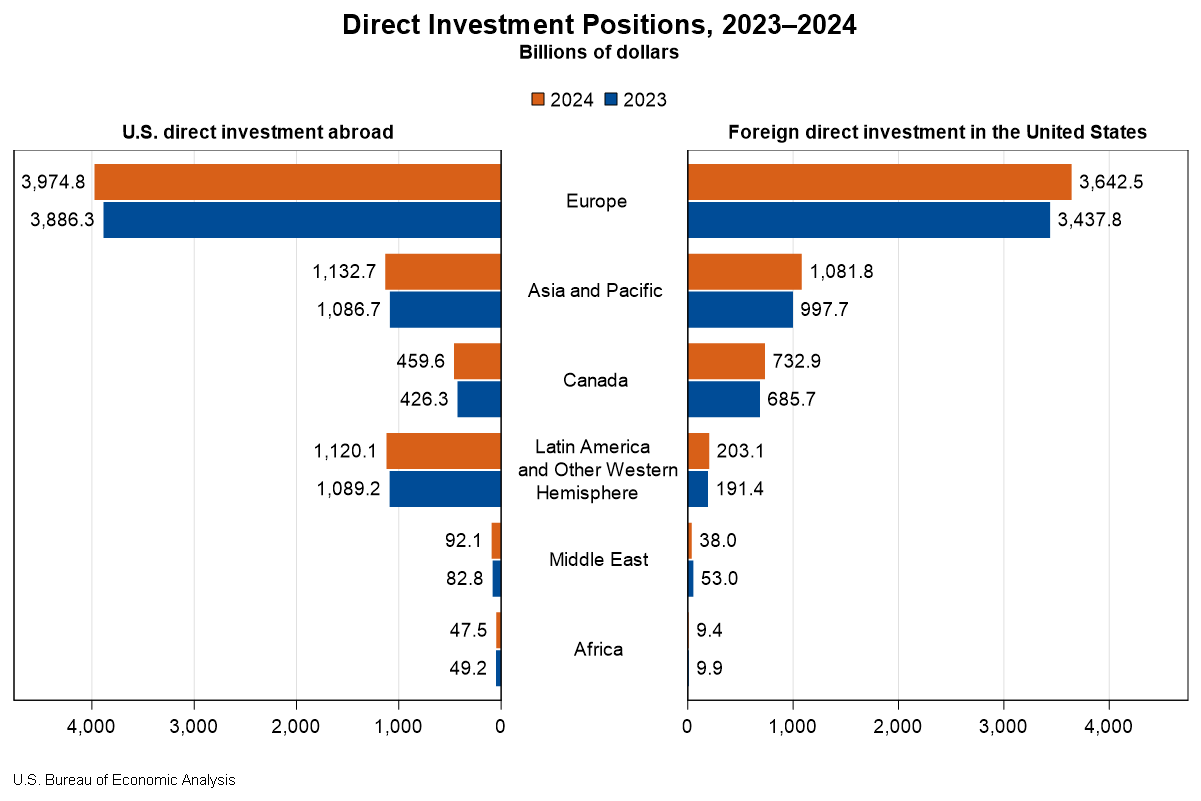Bureau of Economic Analysis
Direct Investment by Country and Industry, 2024
The U.S. direct investment abroad position, or cumulative level of investment, increased $206.3 billion to $6.83 trillion at the end of 2024, according to statistics released today by the U.S. Bureau of Economic Analysis. The increase was led by an $88.4 billion increase in the position in Europe, primarily in Luxembourg and Germany. By industry, manufacturing affiliates had the largest increase, led by manufacturing of computers and electronic products.
The foreign direct investment in the United States position increased $332.1 billion to $5.71 trillion at the end of 2024. The increase was led by a $204.7 billion increase in the position from Europe, which reflected a $52.9 billion increase from the United Kingdom and a $39.7 billion increase from Germany. By industry, affiliates in manufacturing increased the most.
Principal Federal Economic Indicators
Noteworthy
- 2025 News Release Schedule
- Innovation at BEA
- 2025 Annual Updates
- New! Services Trade Data for More Countries
- Data Tool: Trade in Value Added
- Distribution of State Personal Income
- Updated: RIMS II Regional Multipliers
- Arts and Culture
- Space Economy
- FDI Now in State BEARFACTS
- Quick Guide: Price Indexes
The Latest
Personal Income and Outlays, November 2018
Personal income increased 0.2 percent in November after increasing 0.5 percent in October. Wages and salaries, the largest component of personal income, increased 0.2 percent in November after increasing 0.4 percent in October.
GDP Increases in the Third Quarter
Real gross domestic product (GDP) increased 3.4 percent in the third quarter of 2018, according to the “third” estimate released by the Bureau of Economic Analysis. The growth rate was revised down 0.1 percentage point from the “second” estimate released in November. In the second quarter, real GDP increased 4.2 percent.
Gross Domestic Product, 3rd quarter 2018 (third estimate); Corporate Profits, 3rd quarter 2018 (revised estimate)
Real gross domestic product (GDP) increased 3.4 percent in the third quarter of 2018, according to the "third" estimate released by the Bureau of Economic Analysis. The growth rate was revised down 0.1 percentage point from the “second” estimate released in November. In the second quarter, real GDP increased 4.2 percent.
State Personal Income, Third Quarter 2018
State personal income increased 4.0 percent at an annual rate in the third quarter of 2018, an acceleration from the 3.4 percent increase in the second quarter. Personal income increased in all states and the District of Columbia. The percent change in personal income across all states ranged from 6.2 percent in Nevada and Washington to 2.1 percent in Missouri.
State Personal Income, Third Quarter 2018
State personal income increased 4.0 percent at an annual rate in the third quarter of 2018, an acceleration from the 3.4 percent increase in the second quarter. Personal income increased in all states and the District of Columbia. The percent change in personal income across all states ranged from 6.2 percent in Nevada and Washington to 2.1 percent in Missouri.
U.S. Current-Account Deficit Increases in Third Quarter 2018
The U.S. current-account deficit increased to $124.8 billion (preliminary) in the third quarter of 2018 from $101.2 billion (revised) in the second quarter of 2018. As a percentage of U.S. GDP, the deficit increased to 2.4 percent from 2.0 percent. The previously published current-account deficit for the second quarter was $101.5 billion.
U.S. International Transactions, Third Quarter 2018
The U.S. current-account deficit increased to $124.8 billion (preliminary) in the third quarter of 2018 from $101.2 billion (revised) in the second quarter of 2018. As a percentage of U.S. GDP, the deficit increased to 2.4 percent from 2.0 percent. The previously published current-account deficit for the second quarter was $101.5 billion.
GDP for the U.S. Virgin Islands Decreases in 2017 Following Hurricanes Irma and Maria
The estimates of gross domestic product for the U.S. Virgin Islands show that real GDP—GDP adjusted to remove price changes—decreased 1.7 percent in 2017 after increasing 0.9 percent in 2016. For comparison, real GDP for the United States (excluding the territories) increased 2.2 percent in 2017 after increasing 1.6 percent in 2016.
U.S. Virgin Islands GDP Decreases in 2017
The estimates of GDP for the USVI show that real GDP—GDP adjusted to remove price changes—decreased 1.7 percent in 2017 after increasing 0.9 percent in 2016. For comparison, real GDP for the United States (excluding the territories) increased 2.2 percent in 2017 after increasing 1.6 percent in 2016.
First County GDP Numbers Reveal Differences in Local Economies
Real gross domestic product increased in 1,931 of the nation’s counties and decreased in 1,159 counties in 2015, according to prototype statistics from the U.S. Bureau of Economic Analysis. The inflation-adjusted data show GDP unchanged in 23 counties.




